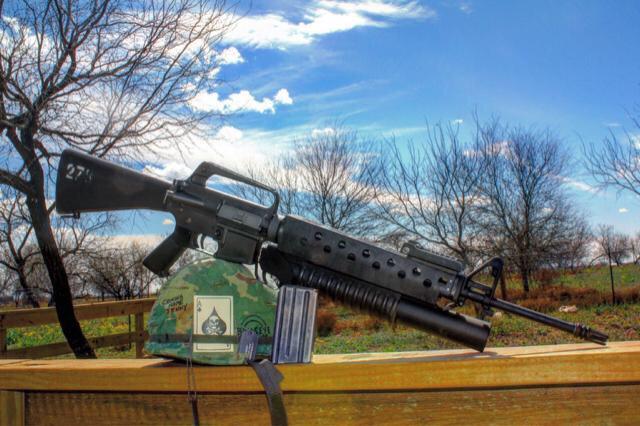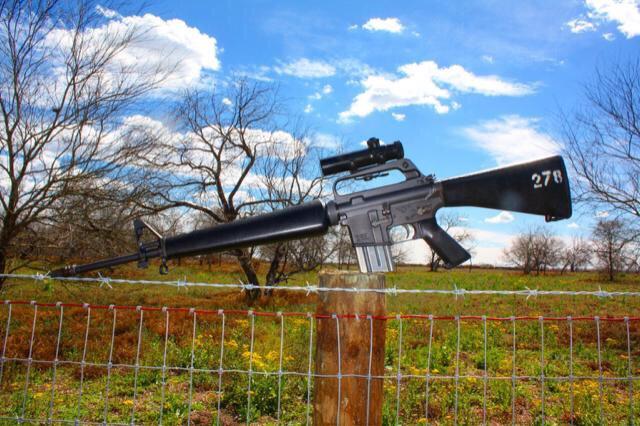-
Legacy Member

Vets and their M16's
I know we are lucky to have several veterans on this forum, and to start, God bless you and thank you for your service. For this thread, I'm interested in those who carried the early M16 /M16A1's, that we base our beloved retro builds off of.
/M16A1's, that we base our beloved retro builds off of.
For those who carried them, I'm interested in hearing:
1. You're experiences with them as a combat weapon. Reliability, accuracy, etc.
2. What kind of personal touches did your weapon have, if any? I.E rack numbers, stickers, cleaning rod taped to stock, grenade launchers, scopes, etc.
3. What equipment were you issued for them?
4. Any tips or tricks when it comes to shooting?
I recently built an almost all USGI clone and have fallen in love with it. It's so lightweight and accurate, all other AR's stay home on range day.
Thanks again!



Information
 |
Warning: This is a relatively older thread
This discussion is older than 360 days. Some information contained in it may no longer be current. |
|
-
-
12-13-2016 09:51 PM
# ADS
Friends and Sponsors

-
-
-
-
Legacy Member

During college we used to draw Delaware NG weapons for use in ROTC FTXs and one time I drew a Hydromantic/GM M16A1, I seem to recall it was a 1968 rifle and still had the grey park/anodized metal finish. It was in pretty nice shape for a 1968 rifle, I doubt it had seen much use. It had a chrome chamber but not the bore, at least that is my recollection that I was told. That would have been in early January of 1983. I seem to recall, but am not sure that that rifle had the solid buttstock and that it was issued with the old bipod container with a cleaning kit in it, but no bipod. Those rifles did not have stock rack numbers but a small copper/brass circular tag (with a number) on the forward sling swivel when we got them. This was wired on and we carefully removed them and save them, to be put back on when the rifles were returned.
Prior to returning them they had to be absolutely spotless. That means you had to have everything sufficiently clean that none of the copious amounts of blank powder carbon was left, which was very difficult to do with the material we had in the cleaning kits. The cleaning kits that came in the bipod cases we had did not have the tooth brush or much of anything, I do not even recall a good chamber brush, I seem to recall we had to use old toothbrushes to clean that area and all we had to clean/lube was LSA and lighter fluid along with paper towels. We did have cleaning patches, which we cut to make the right size..
During Small Arms firing school in the late 1980s, I think it was 1989, the rifle I drew was an old XM16E1 that had been rebuilt at RIA in 1975 and was so marked on the front right hand side of the magazine well. It had a chrome chamber and bore, obviously a replacement. The finish on the upper and lower was some kind black paint, at least it looked like it. Very loose fit between upper and lower. Still shot expert on the old 300 M known distance course...not sure but it was the D and E targets at 200 and 300 yards/meters (forget which).
Never saw an open flashider or any kind of assist but the teardrop version. Never saw a chrome bolt carrier. Never saw any kind of charging handle but he one used today. All the rifles as they came to us had the full selector feature blanked off with a pot metal plate that went between the pistol grip and the lower receiver, to remove it you had to have a screwdriver. You could also snap it with a P38 can opener and then claim you had no idea how it got that way. None of the rifles were all that worn, none had the absolute lack of finish on raised surfaces that you see in various pictures of rifles that have been in the field for much time or basic training guns. Still it is my recollection that the rifles were pretty loose and had a fair amount of play between the upper and lowers.
My impression of the M16A1 was pretty good, but that said I had never fired any real gun prior other than open sighted 22 rifles and perhaps a shotgun. The peep sight took some getting used too, but I recall that on a moon-lite night the rear rail and front sight post could sort of be used as a alignment device, that is until you got into the woods. Not sure how effective in the real world as I never fired anything at night but blanks, but I would have supposed in good light you could be pretty sure of dumping your rounds on a man sized object at 50 yards. The blanks produced flash at night on full automatic and it occurred to me if you actually fired at night you would likely not have a long life in a real battle if the regular rounds produced that much flash.
The only real issue I recall was that in firing the trainfire course or alternative A at 25 meters you had to be really conscious of the non-firing hand position. Back then the qualification course was 40 rounds, all prone, half in foxhole and half prone unsupported. I think we got 9~10 rounds to zero the rifles, something like 2- 3 shot groups and one final 4 shot group. If you used sandbag support on the forward end of the forestock and then went to hand pressure back towards the rear of the handguards in the unsupported position, you would see a group shift. The sling would make things a wee bit worse (old M1 sling is what we had)
sling is what we had)
Never fired a shot in anger my entire life so no real practical knowledge.
-
Thank You to Frederick303 For This Useful Post:
-
Legacy Member

Very interesting post I hope for lots of feedback.
-
-
Legacy Member

I noticed your stock with the rack number. There used to be a lot of real nice condition ex National
Guard plastic sets for sale a few years ago. The sets I got were excellent condition. I got them
for my m16s, then got some more for spares. There also were the bipod in carry cases.
I don't know if they were issuing new m16a2 plastic sets or destroying the guns.
-
-
Advisory Panel


I had an TRW M14 in Basic Training at Fort Knox Ky, April 22, 1969. It had the brown fiberglass stock that made it easier to find when stacking arms. I was very unhappy to find that my rifle was about 1.5 lbs heavier than the wood stocked 14's. about a week before graduation. We fired one 20 rd. magazine in an M16 for familiarization fire. After Signal Corps fixed base communications training I was sent to an Island in the bay of Panama, guarding the entrance to the Panama Canal. We had M14s. Later the 14s were withdrawn (mid 1970) and we were issued brand new in the cardboard box GM HyrdoMatic M16A1s. The general feeling was that the hydros did not group as well as the Colts.
in Basic Training at Fort Knox Ky, April 22, 1969. It had the brown fiberglass stock that made it easier to find when stacking arms. I was very unhappy to find that my rifle was about 1.5 lbs heavier than the wood stocked 14's. about a week before graduation. We fired one 20 rd. magazine in an M16 for familiarization fire. After Signal Corps fixed base communications training I was sent to an Island in the bay of Panama, guarding the entrance to the Panama Canal. We had M14s. Later the 14s were withdrawn (mid 1970) and we were issued brand new in the cardboard box GM HyrdoMatic M16A1s. The general feeling was that the hydros did not group as well as the Colts.
-
-
Advisory Panel



Originally Posted by
breakeyp

GM HyrdoMatic M16A1
Kind of a hard one to find now...guess they used them completely up.
-
-
Legacy Member

Kind of a hard one to find now...guess they used them completely up.
Local Sherriff sent a few back to the state along with three Winchester 1200 trench guns a few years back. I think the state provided some plastic pistols in return.
Ouch.
-
-
Advisory Panel



Originally Posted by
HOOKED ON HISTORY

Local Sherriff sent a few back to the state
Yes, I did hear about the odd LEO that still had a couple or so sequestered...
-
-
Advisory Panel


Kind of a hard one to find now...guess they used them completely up.
Many were rebuilt to A2 status.
I understand that most of the m16 based "precision" SPR rifles have early XM and M16A1 lowers.

Originally Posted by
browningautorifle

Yes, I did hear about the odd LEO that still had a couple or so sequestered...
The federal "aid to law enforcement" programs has resulted in distribution of various obsolescent equipment from armoured vehicles to rifles and machine guns.
Various early AR15 and XM16 variants have surfaced from the very first experimental and trials rifles, sometimes in original parts condition (buffers, charging handles ect).
Last edited by Lee Enfield; 12-15-2016 at 08:42 AM.
-
/M16A1's, that we base our beloved retro builds off of.
 Information
Information
















 PM
PM









